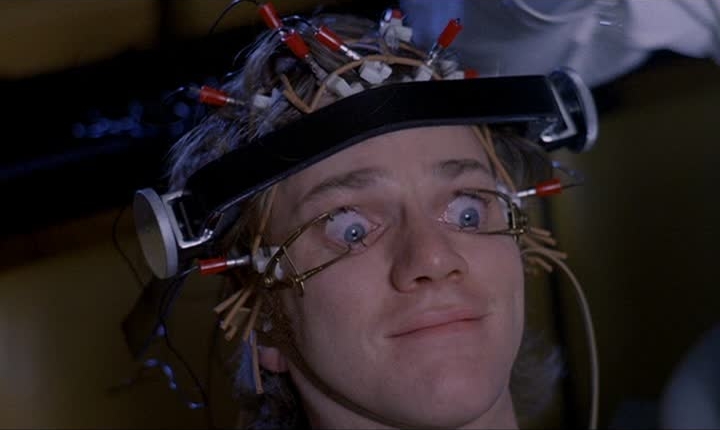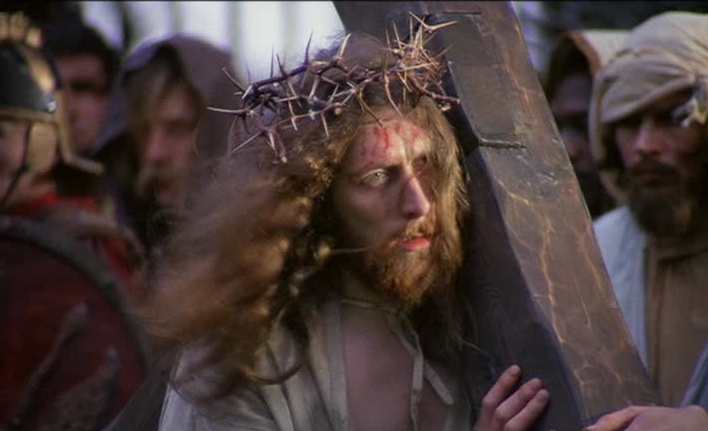[Please play the music].



(Pointed out by somebody here: http://pronountrouble2.wordpress.com/2010/03/30/kubrick/)
Similar, ain't they?
It doesn't seem to be accidental, but I don't know what to make of it.
In a sense Stanley Kubrick's similar to Leonardo da Vinci, both left tons of symbols and ambiguities and mysteries in their works that long after their death people still talk about them and try to find the truth.
2/ The paintings in "Eyes wide shut":
http://www.archiviokubrick.it/opere/film/ews/quadri.html
3/ These are the 6 weirdest theories about the real meaning behind "The shining":
http://www.motherjones.com/mixed-media/2013/04/overlook-6-strangest-creepiest-theories-about-shining
Pay attention to no.5:
You can read more here: http://en.wikipedia.org/wiki/Moon_landing_conspiracy_theories
To be frank, I generally have a negative view of conspiracy theories (9/11, The Holocaust...) and therefore I reject as silly the idea that NASA faked moon landing, but this analysis with all those arguments does make sense to some extent:
THE KUBRICK CODE:
"In the case of Kubrick, his films are very difficult to decrypt for several reasons.
1. We are dealing with an artist who has an especially strong understanding of many subjects and disciplines including psychology, symbolism and semiotics (the art of subjectively encrypting messages).
2. His messages tend to be cerebral rather than emotional – frequently relating to his opinions of broad historical and social issues, of which the average person has a comparatively weak understanding.
3. His symbolic encoding operated on a deliberate level of complexity that is almost unheard of, even in the history of the arts, and is comparative to the skills of an advanced mathematician.
4. Most people who watch Kubrick films are not actually aware that there are encrypted messages waiting to be cracked."
"[S]ome of the key encryption concepts that Kubrick used throughout his filmography.
1. Role switching & character synthesis
This involves the audience mentally placing one character’s identity into the body of another so that a different narrative begins to surface. It was used extensively in Eyes Wide Shut so that characters from Victor Zeigler’s high society party were revealed as being participants in the Somerton mansion orgy. This in turn revealed that the two parties were in fact one and the same, the first being wrapped in lies and illusion and the next stripped of such illusions to reveal an underlying moral decadence. The naked woman who sacrificed herself to protect Bill was also a psychological synthesis of Alice, Mandy and Domino – which revealed a hidden message of all women being viewed by Bill as stereotypical sex objects.
The character switching concept was also used in Full Metal Jacket, where Private Pile and Animal Mother represented psychological opposites of the same mind. This in turn was a clue to the films theme of split identity and disassociation induced by military brainwashing.
2. Paintings as metaphoric mirrors
Again Eyes Wide Shut made extensive use of this device. The masked orgy participants and guests at Ziegler’s party were revealed, through the paintings adorning the mansion walls, as members of European nobility – the clue to this concept was made most obvious in Ziegler’s bathroom, where Mandy lay overdosing on a red sofa, while up on the wall could be seen a large painting of an identically posed woman on a red sofa.
Another excellent example of this was in A Clockwork Orange, in which the woman who Alex kills has a painting on her wall depicting a woman with the breasts cut out of her clothing. This reveals that the warped sexual fantasies we see in Alex’s behaviour, who had cut the breasts out of his rape victim’s clothing, are a larger social trend which Alex is simply conforming and reacting to.
3. Mirror-framed characters as symbolic reflections
The most frequent use of this concept in a Kubrick film was The Shining. Whenever Jack sees a ghost it virtually always stands with a mirror behind it – the bar tender, Delbert Grady, the corpse woman. This was a key to the film’s hidden narrative that the hotel was not actually haunted, but that the family were haunted by their repressed memories of Jack’s brutality and America’s bloody history.
4. Subliminal repetition between scenes
This was a very frequent Kubrick device. As already mentioned, the two party scenes of Eyes Wide Shut contained a multitude of aesthetic similarities such as paintings of nobility, dancing couples and masks that roughly imitate the facial features and hairstyles of actual characters.
5. Double speak
Also a favourite Hitchcock approach, this involves dialogue that has no reference to a specific context and can therefore carry meaning both in the obvious surface narrative and in the hidden narrative. For example, in Full Metal Jacket an indication of Private Pile’s double identity as Animal Mother is when the drill instructor says “Private Pile, you are definitely born again hard”. Another good example can be found in Eyes Wide Shut. While dancing with Alice, Sandor Szavost says “One of the charms of marriage is that it makes deception a necessity for both parties”, the two parties being a sly reference to both Ziegler’s Party and the Sommerton mansion orgy.
6. Multiple meaning in one symbol
This is one of the most confusing devices of Kubrick and he used it with a skill that is unmatched. In Eyes Wide Shut the huge star shaped Christmas decorations have several meanings – they represent giant snow flakes, but also the hypnotic illusions of high society, and some reviewers have interpreted them as secret society symbols or as astrological symbols.
The monolith in 2001 represents in the surface narrative - God, a doorway to another dimension and a piece of alien intelligence, while in the hidden narratives it represents the cinema screen (as well as a few more meanings which we shall explore shortly).
7. Lingering shots
This is a Kubrick method that has lead many people to label his films as painfully slow. When he holds a shot on screen for an unusually long period of time, it is often to emphasize the symbolic elements and allow us time to ponder over the meanings of what we’re seeing and hearing. Sometimes Kubrick also leaves scenes in complete silence to encourage visual exploration of the shots.
8. Wide angles
This is the main factor that has led some critics to label Kubrick’s work as cold and emotionless. Rather than being an aesthetic preference it is frequently used when set design and compositional elements are carrying meaning, as opposed to acting and dialogue alone.
9. Fractional messaging
These can be especially hard to decode. It involves a concept being divided up into several sub-concepts and then embedded in different shots and scenes. The viewer must cross reference information throughout the film and piece the concept back together. The clues I have already described as to the meaning of the monolith are a good example of fractional messaging.
10. External symbols
This involves messages being delivered to the audience outside of the actual movie content. They can come in many forms such as being embedded in a marketing campaign or deliberately falsified rumours about the shoot.
In Eyes Wide Shut Kubrick worked with Tom Cruise and Nicole Kidman, who were married both in real life and in the film’s story. The couple were featured in the marketing poster as being reflected in a silver-framed mirror, revealing that the content of the film was a metaphoric reflection of the audience’s reality. Another example of this would Kubrick’s rumours of endless takes in filming a single shot. These rumours were probably true in some cases, but also could have been made up to bring greater audience attention to particular shots. In the case of 2001, the many bizarre posters and production stills are embedded with very obvious clues about the films hidden meanings.
11. Colour association
This comes in several forms. It can be based upon bio-semiotics, which is the audience’s genetically inbuilt associations. For example red equals hot and blue equals cold or black plus yellow equals danger. It can be based upon popular cultural association such as red, white and blue representing an English or US flag. Kubrick on the other hand, often would set up unique colour associations that are not natural to the audience. In Eyes Wide Shut the red pool table of Zeiglers parlour combined with blue lighting from the windows links the scene conceptually to the bright red carpet and blue lighting of the orgy ritual. 2001 has many colour association themes that have made their way into this review.
12) Dream logic
This method combines narrative logic with the symbolism of dreams. For example, in Eyes Wide Shut the story changes from conventional logic to dream logic after Bill has a pot smoking session with his wife.
A unique trick of Kubricks was to film a dream sequence, but let the audience assume it is part of the actual narrative. The room 237 sequence of The Shining is a great example. In the surface narrative the room is haunted by the ghost of a dead woman, but in the hidden narrative it is Danny having a flashback or nightmare to having been strangled by his father for waking him up in an earlier scene. It is typical for victims of abuse to identify with their abuser and so Danny re-experiences the event as his own father, while externalising the abuser as a mysterious rotting corpse."
(from http://www.collativelearning.com/2001%20chapter%203.html)
Having written long posts about symbols and messages hidden in Stanley Kubrick's films, I admit that it's not necessarily a good thing. Such talks easily create on strangers (those unfamiliar with his works) the impression that his films are fascinating because of their ambiguities rather than because of what usually makes a film fascinating, such as plot, story, characters, acting, cinematography, colours, scenery, etc.
That is horribly wrong (the fault is entirely my own).
If you care to see his films, and better, if you by any chance enjoy his films as I do, I hope you find these posts enjoyable and thought-provoking and if you do, I shall be very glad. That's all I'd like to say.
No comments:
Post a Comment
Be not afraid, gentle readers! Share your thoughts!
(Make sure to save your text before hitting publish, in case your comment gets buried in the attic, never to be seen again).